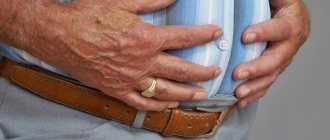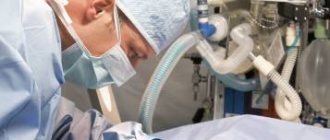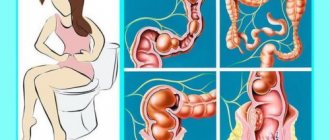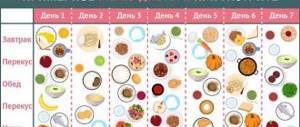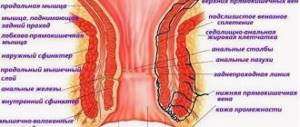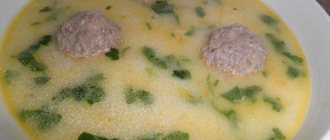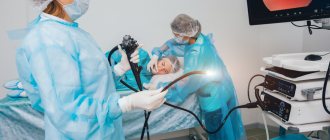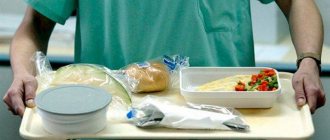One of the reasons for the development of digestive tract diseases in adults is poor nutrition. Therefore, before prescribing drug therapy for neoplasms in the gastrointestinal tract, the gastroenterologist pays special attention to food and methods of its preparation. The menu depends on the type of pathology, secretory and motor function. The diet for polyps in the stomach has certain differences.
The patient needs to know which permitted products can be included in the daily menu and which are contraindicated.
Polyp in the stomach
Pathology is more common in older people. The disease can occur without clinical symptoms or under the guise of inflammation. It is characterized by the appearance of additional formations on the mucous membrane. The morphological types of gastric polyps depend on the cells from which they are formed. The histological structure and extent of the process presupposes a certain course of the disease and prognosis. For convenience, specialists are guided by the following classification.
Table 1. Classification
| Category | Options |
| To size |
|
| By appearance | Speakers:
Surface:
|
| In count | Singles Multiple Nesting Polyposis |
| By location in the sections of the stomach | Antrum Pylorus Cardia Combined with other organs |
| By morphological type | Adenomatous - develops from glandular epithelium; Hyperplastic - formed due to hyperplasia of the surface epithelium; Hyperplasiogenic - noted when the regenerative processes of the epithelium are disrupted; Fundic glands - represented by dilated acid-producing cells |
Treatment
The type of care for the disease is determined by the gastroenterologist after receiving data from an objective and additional examination. Conservative approach or surgical intervention - the choice will depend on what kind of polyp is in the stomach. Treatment is prescribed only in conjunction with a diet. Because nutrition is important at any stage of recovery.
Drug therapy includes antispasmodics, antacids, antisecretory agents, and drugs that improve the regeneration of the mucous membrane. When Helicobacter pylori infection is detected, antibacterial substances, bismuth subcitrate and proton pump blockers are added.
What is a stomach polyp, how to treat it and is it dangerous?
If a polyp is removed, a special menu is recommended. Rough food and products that irritate the digestive tract are contraindicated. The expansion of the diet is carried out sequentially. They start with liquid dishes, gradually adding new components so as not to mechanically injure the tissue.
Prohibited Products
The list of prohibited foods includes all those that are difficult to digest in the gastrointestinal tract. They should be abandoned completely and not consumed even in small quantities. Among the most dangerous foods for the health of the liver and gallbladder are:
- fats of animal origin, including during the preparation of other dishes;
- fatty varieties of fish and meat, even boiled;
- fast food, fast food high in fat;
- fresh baked goods, especially those made from wheat flour;
- sauces, spices, mayonnaise, ketchup and other seasonings;
- confectionery, especially sweets and chocolate;
- any alcoholic and carbonated drinks;
- some vegetables: legumes, spinach, sorrel, onions and garlic.
All these products can be divided into two groups. The first of them contains a large amount of fat, so to break down these dishes you will need a lot of bile. It begins to be synthesized in the liver in increased quantities, overflowing the walls of the gallbladder and provoking the growth of polyps. The second group (spices, some vegetables, fast food) irritate the mucous membrane of the stomach and intestines, and the processes of parietal digestion in the intestines are disrupted. For this reason, such dishes are not recommended to be consumed even in small quantities.
Prohibited foods are those that can cause bile stagnation or irritate the intestinal mucosa
Principles of diet for gastric polyps
If the pathology is confirmed, the patient needs to change the approach to preparing and eating food. To ensure that dietary nutrition for gastric polyps promotes rapid recovery, adhere to the following principles:
- Select products that contain vitamins, nutritional components and minerals that cover the daily requirement.
- The amount of food calculated per day is divided into 3 main and 2-3 additional meals.
- The volumes of each portion should be small; the break between snacks and main portions should be no more than 3 hours.
- Avoid eating 2 hours before bedtime and at night.
- It is better to prepare dishes before consumption; storage for more than 24 hours is prohibited.
- You should not eat too hot or cold food, so as not to irritate the digestive tract. You can eat the food warm.
- Vegetable oil is added to cooked foods, which coats the stomach.
- It is worth giving preference to single-component dishes.
- Cooking methods include boiling, stewing, steaming, and sometimes baking in the oven.
Attention!
The effectiveness of the diet is assessed by the disappearance of clinical symptoms and improvement of the patient’s condition.
Results and reviews
Dietary nutrition after removal of gastric polyps allows you to restore full gastrointestinal function in a relatively short time, as evidenced by patient reviews.
- “... An ulcer sufferer with extensive experience. During the last exacerbation, examination revealed an adenomatous polyp in the antrum of the stomach. Two months later he was operated on as planned. I've been on the diet for almost six months now. And as I was told, I should be on this diet to prevent the regrowth of polyps at least 2 times a year, during the period of spring and autumn exacerbation of peptic ulcer disease”;
- “... An endoscopic examination diagnosed a polypoid tumor in the antrum of the stomach. Endoscopic surgery was recommended. While I am under clinical observation, I was prescribed Diet No. 1. I’m preparing mentally for the operation.”
What can you eat if you have polyps in your stomach?
Despite the restrictions, you can prepare delicious dishes. It is important to adhere to the rules for combining permitted products. This is necessary for complete absorption of the components. The following list of foods that you can eat with polyps in the stomach is recommended:
- low-fat milk cheeses, hard and fermented milk;
- oils - sunflower, corn, olive;
- confectionery sweets of soft consistency - marshmallows, marshmallows without chocolate, marshmallows, nougat;
- rich pastries without yeast, wheat bread, cookies, gingerbread without filling;
- boiled eggs;
- porridge;
- decoctions of vegetables;
- pasta based on durum wheat;
- potatoes, beets, carrots, cauliflower, broccoli, pumpkin - stewed, steamed.
- lean meats - veal, rabbit, chicken;
- low-fat dairy products - sour cream, yogurt, whole milk.
Features of dietary nutrition
The main goal of therapeutic nutrition for polyposis is to reduce the physiological load on the gastrointestinal tract. Weakened immunity, difficulty in digestive processes and aggressive food - all this depresses not only the general condition of the body, but also stimulates the growth of new polypous neoplasms.
Diet planning depends greatly on the acidity of the stomach.:
- Low acidity suggests in the diet foods that stimulate the secretion of gastric juice. The menu must include liquid dishes, steamed or boiled ingredients. It is acceptable to eat boiled sausages made from natural meat, unsaturated broths, and low-fat cheeses.
- Increased acidity requires the inclusion of slimy soups, cereals, and vegetable broths in the diet. It is important to drink plenty of fluids to reduce excess acidity. It is unacceptable to eat fatty, hot and spicy foods.
Healthy nutrition is necessary for gastric polyps of any location. However, with a prepyloric polyp, the risks of tissue malignancy and disruption of stomach functionality increase sharply.
Important! The diet should include mucus foods suitable for low stomach acidity. Also, be sure to include fresh fruits and vegetables, previously pureed, in your diet.
What products are contraindicated
Many edible ingredients are prohibited from being eaten, and some should be limited. A strict ban applies to alcoholic beverages, marinades, smoked, fried, and spicy foods.
Contraindicated products for polyps in the stomach include:
- fatty meats and fish - pork, lamb, salmon, mackerel;
- corn, radishes, radishes, white cabbage, beans, peas, tomatoes;
- dairy products with a high percentage of fat content;
- chocolate, coffee;
- herbs, spices;
- citrus fruits, sour fruits and raw berries;
- bread and baked goods made with yeast;
- butter.
Indications for use
A diet for polyps in the gallbladder is prescribed when neoplasms are detected on the mucous membrane as a measure of prevention and treatment, if the neoplasms have not yet reached alarming proportions and do not threaten to block the normal activity of the natural reservoir for storing bile produced by the liver. Detection at the initial stage, in addition to diet, involves constant monitoring of their growth and condition. In case of high activity, surgical treatment is used and a new dietary restriction will be required after the operation.
Timely diagnosed polyposis can be corrected by changing the composition of bile secretion. This is exactly what the diet for polyps in the gallbladder is used for. Irregular and uneven nutrition leads to stagnation in the sac-like organ, designed by nature to concentrate and store bile. With the help of fractional and constantly taken meals, you can establish a constant supply of bile from the storage site. This will prevent stones from forming and inflammatory processes from starting. Cholesterol polyps appear due to excess production of the compound by the liver or its constant intake through food.
The appearance of polyps most often results from chronic cholecystitis or cholelithiasis, and these are pathologies that require strict adherence to dietary restrictions. The diet for gall bladder polyps is aimed at several important goals at once. It allows:
- avoid additional stress on the digestive organs;
- normalize cholesterol and lipid metabolism;
- optimize bile flow;
- achieve a change in the qualitative composition of bile secretion;
- provide the patient with all necessary nutritional components in quantities sufficient for normal life activities, but not excessive.
Prescription of diet and conservative treatment is considered useless if the formations are complex and multiple and exceed a size of 10 mm. In this case, cholecystectomy is clearly recommended and compliance with the rules of food intake will be aimed at maintaining digestion at the proper level after the operation. However, if they are stable and small in size, then the classic diet No. 5, developed by Pevzner several decades ago, is recommended, and remains unsurpassed in action and relevant in many cases.
What can you drink
For patients with gastrointestinal pathology, it is necessary to maintain a drinking regime. The daily amount of fluid for an adult is 1800-2000 ml. Water should be consumed about half the normal amount. Other permitted drinks for stomach polyps are:
- jelly and compotes from apples, pears, peaches, plums, apricots, strawberries;
- vegetable juices from carrots, pumpkin, beets, including mixed ones;
- weakly brewed green or black tea;
- decoction of rose hips, dried fruits;
- fruit nectars or non-acidic juices, diluted with water.
You should avoid fresh or sour juices, given their likely irritating effect on the gastrointestinal mucosa.
Important!
Potato juice is a natural remedy, so it is taken in limited doses on the recommendation of a doctor.
Diet goals
The nutrition of a patient who has undergone surgery to remove a polyp in the stomach is organized in accordance with his condition.
After surgery, you need to take measures to heal the wound surface and prevent it from being injured by food particles, so as not to cause complications. Therefore, the main goal of the diet is to protect the mucous membrane from mechanical, thermal and chemical damage.
It is also important to restore the patient’s body by providing it with the necessary vitamins and microelements. In the period before surgery, the patient is also forced to follow a diet, which leads to vitamin deficiency and a lack of certain substances.
On this topic
- Digestive system
Differences between sigmoidoscopy and colonoscopy
- Natalya Gennadievna Butsyk
- December 9, 2020
Blood loss may occur during surgery. These difficulties must be neutralized with the help of properly organized nutrition. Thanks to this, recovery will go faster.
In this regard, the second goal is to organize physiologically complete nutrition, in which the patient can obtain the substances he needs from food. This will restore the level of proteins, minerals and vitamins. But the products should not be heavy and irritate the stomach.
Another feature is taking into account the characteristics of the patient’s condition. Due to individual differences, the postoperative recovery process occurs at different rates.
It is necessary to monitor the patient's condition and promptly adjust the diet in accordance with his needs. He should gradually return to his normal diet.
Sample menu for the week
Dietary restrictions should not affect the variety of dishes. Originally prepared food affects appetite and absorption of food components. You can create a complete diet from permitted foods. An approximate menu for a stomach polyp for a week by day is as follows.
Monday
| Watch | Menu |
| 9.00 | Oatmeal; steamed omelette; black tea |
| 11.00 | Paste; cookie |
| 13.30 | Soup with meatballs and vegetables; mashed potatoes with boiled chicken; rosehip decoction |
| 16.00 | Cottage cheese casserole |
| 19.00 | Buckwheat porridge; beef meatball; dried fruits compote |
Tuesday
| Watch | Menu |
| 9.00 | Milk buckwheat porridge; green tea |
| 11.00 | Fruit jelly, gingerbread |
| 13.30 | Rice soup; vegetable stew; rabbit zrazy; apple compote |
| 16.00 | Yogurt; biscuits |
| 19.00 | Lazy dumplings; sour cream; rosehip decoction |
Wednesday
| Watch | Menu |
| 9.00 | Meat soufflé, oatmeal, black tea |
| 11.00 | Marshmallow; pear nectar |
| 13.30 | Stewed potatoes with chicken; beet salad; peach jelly |
| 16.00 | Banana; biscuit |
| 19.00 | Meatballs with vegetables and veal; dried fruit decoction |
Thursday
| Watch | Menu |
| 9.00 | Semolina mousse; plum-apple jelly |
| 11.00 | Fruit jelly; bagels |
| 13.30 | Vegetable soup; mashed potatoes, steamed fish; Rose hip decoction |
| 16.00 | Yogurt; applesauce |
| 19.00 | Buckwheat porridge; boiled egg; green tea |
Friday
| Watch | Menu |
| 8.30 | Chicken pudding; hard cheese; pear-apple compote |
| 11.00 | Cottage cheese casserole |
| 13.00 | Vermicelli soup; vegetable stew; boiled beef |
| 16.30 | Yogurt; cookie |
| 19.00 | Fish and vegetable casserole; black tea |
Saturday
| Watch | Menu |
| 9.00 | Milk buckwheat soup; hard cheese; tea |
| 11.00 | Apricot jelly; biscuits |
| 13.30 | Lenten borscht; rice porridge, steamed chicken cutlets; dried fruits compote |
| 16.00 | Baked apple |
| 19.00 | Rice porridge, white omelette; rosehip decoction |
Sunday
| Watch | Menu |
| 9.00 | Pumpkin and cottage cheese casserole; milk jelly |
| 11.00 | Fruit pastille |
| 13.30 | Vegetable puree soup; mashed potatoes with turkey meatballs |
| 16.00 | Yogurt; biscuit |
| 19.00 | Stuffed cabbage rolls with minced meat and vegetables; green tea |
Acceptable menu after polyp removal: what can you eat, what can’t you eat?
For the first two months after surgery, it is important to organize proper nutrition. Usually, table No. 5 according to Pevzner is prescribed, which is used for severe diseases of the gastrointestinal tract and during the postoperative recovery period.
The following foods are acceptable to eat:
- slimy porridges and soups;
- jelly, berry fruit drinks, dried fruit compotes;
- steamed meat or fish cutlets (minced meat is passed through a meat grinder 2-3 times);
- vegetables are steamed.
Sample menu for the day:
- Morning . Milk porridge, sandwich with butter, tea with milk.
- Second breakfast . Gingerbread and a glass of jelly.
- Dinner . Steamed fish cutlet, mashed potatoes, berry juice.
- Afternoon snack . Cookies with kefir.
- Dinner . Buckwheat without salt with a glass of berry jelly.
In the first weeks, you should not drink concentrated juices, strong tea or coffee. Under no circumstances should you drink alcohol or smoke!
A diet that requires only 100 grams per day will be effective. proteins, 500 gr. carbohydrates, 80-90 gr. fat The total daily calorie content should not be more than 3000 Kcal.
For a speedy recovery, you need to eat viburnum (berries, viburnum decoction, juice), oil or sea buckthorn juice (1 teaspoon before meals).
Recipes for simple and tasty dishes for patients with polyps in the stomach
Patients who are prescribed a diet do not always adhere to it. In some cases, food for stomach polyps is monotonous. Or it is considered tasteless when you can’t eat your usual dishes. Therefore, you should think about expanding the menu to include components that can be eaten. However, cook them differently, as the cookbooks suggest.
| Name | Recipe |
| Meatballs with rice and vegetables | The meat is twisted through a meat grinder. Combine it with half-cooked rice and an egg and mix. Add pepper and salt to taste. Take some water into a saucepan, add salt and bring to a boil. Place minced meat balls with rice one at a time into boiling water. Separately, sauté onions and carrots in vegetable oil until half cooked. Bring the meatballs to a boil, add vegetables and cook over low heat until tender. |
| Steamed omelette with vegetables | Vegetables - carrots, zucchini, cauliflower - are cut into small pieces and placed in a double boiler. Sprinkle a little salt on top. Beat the egg with a whisk, add a little milk and salt. When the vegetables become soft, pour them with the egg-milk mixture and leave to steam for 10-15 minutes. |
| Pumpkin-apple marshmallow | Prepare separately puree from boiled pumpkin and baked apples. Add sugar. Separately, beat the egg white with a mixer until foamy, then add a little sugar. Combine fruit puree and protein and mix thoroughly. Dry in the oven for 4-6 hours at a temperature of 40 degrees on parchment moistened with vegetable oil. The hot marshmallow is removed from the paper and cut into cubes. |
The diet should not only be healthy, but also tasty. Only in this case will patients adhere to a healthy diet, which will have a positive effect on the results of treatment.
Authorized Products
The diet for polyps in the gallbladder in the preoperative period and during the recovery stage after their removal includes dried wheat bread/white crackers, and, if tolerated, rye bread or made from peeled flour. Soups are prepared in weak vegetable broths with the addition of vegetables, cereals and noodles, with the addition of unsalted butter or low-fat sour cream without frying.
To prepare second courses, it is recommended to use veal, lean beef, rabbit meat, poultry (chicken, turkey) boiled/baked, chopped or in pieces. The diet can include low-fat white river/sea fish with vegetables and boiled seafood. Vegetables are baked, boiled or steamed and served in the form of salads, vinaigrettes, caviar, seasoned with vegetable oils or sour cream.
Chicken eggs - exclusively in the form of steam omelettes or boiled soft-boiled, preferably without yolks. The diet should include low-fat fermented milk products: kefir, acidophilus, yogurt, low-fat cottage cheese (in the form of casseroles and natural). Milk may only be used as an additive to dishes and tea. Sour cream and butter - as a seasoning for ready-made dishes.
Cereals should be well boiled. For spices, you can use garden herbs and add cinnamon to sweet dishes. As a dessert, you can include non-acidic fruits/berries in any form, marmalade, jam, honey in your diet. It is better to partially replace sugar with xylitol. Consume free liquid in sufficient quantities, mainly in the form of tea/coffee with milk, rosehip infusion, vegetable/fruit juices, non-carbonated mineral water.
Table of permitted products
| Proteins, g | Fats, g | Carbohydrates, g | Calories, kcal | |
Vegetables and greens | ||||
| eggplant | 1,2 | 0,1 | 4,5 | 24 |
| zucchini | 0,6 | 0,3 | 4,6 | 24 |
| cabbage | 1,8 | 0,1 | 4,7 | 27 |
| broccoli | 3,0 | 0,4 | 5,2 | 28 |
| carrot | 1,3 | 0,1 | 6,9 | 32 |
| cucumbers | 0,8 | 0,1 | 2,8 | 15 |
| salad pepper | 1,3 | 0,0 | 5,3 | 27 |
| parsley | 3,7 | 0,4 | 7,6 | 47 |
| iceberg lettuce | 0,9 | 0,1 | 1,8 | 14 |
| tomatoes | 0,6 | 0,2 | 4,2 | 20 |
| pumpkin | 1,3 | 0,3 | 7,7 | 28 |
| dill | 2,5 | 0,5 | 6,3 | 38 |
Fruits | ||||
| bananas | 1,5 | 0,2 | 21,8 | 95 |
| apples | 0,4 | 0,4 | 9,8 | 47 |
Nuts and dried fruits | ||||
| raisin | 2,9 | 0,6 | 66,0 | 264 |
| dried figs | 3,1 | 0,8 | 57,9 | 257 |
| dried apricots | 5,2 | 0,3 | 51,0 | 215 |
| dried apricots | 5,0 | 0,4 | 50,6 | 213 |
| prunes | 2,3 | 0,7 | 57,5 | 231 |
Cereals and porridges | ||||
| buckwheat | 4,5 | 2,3 | 25,0 | 132 |
| oatmeal | 3,2 | 4,1 | 14,2 | 102 |
| pearl barley porridge | 3,1 | 0,4 | 22,2 | 109 |
| rice | 6,7 | 0,7 | 78,9 | 344 |
Flour and pasta | ||||
| pasta | 10,4 | 1,1 | 69,7 | 337 |
| buckwheat noodles | 14,7 | 0,9 | 70,5 | 348 |
Bakery products | ||||
| bran bread | 7,5 | 1,3 | 45,2 | 227 |
| whole grain bread | 10,1 | 2,3 | 57,1 | 295 |
Confectionery | ||||
| jam | 0,3 | 0,2 | 63,0 | 263 |
| jelly | 2,7 | 0,0 | 17,9 | 79 |
| marshmallows | 0,8 | 0,0 | 78,5 | 304 |
| milk candies | 2,7 | 4,3 | 82,3 | 364 |
| fondant candies | 2,2 | 4,6 | 83,6 | 369 |
| fruit and berry marmalade | 0,4 | 0,0 | 76,6 | 293 |
| paste | 0,5 | 0,0 | 80,8 | 310 |
| Maria cookies | 8,7 | 8,8 | 70,9 | 400 |
Raw materials and seasonings | ||||
| honey | 0,8 | 0,0 | 81,5 | 329 |
| sugar | 0,0 | 0,0 | 99,7 | 398 |
Dairy | ||||
| kefir 1.5% | 3,3 | 1,5 | 3,6 | 41 |
| Ryazhenka | 2,8 | 4,0 | 4,2 | 67 |
Cheeses and cottage cheese | ||||
| cottage cheese | 17,2 | 5,0 | 1,8 | 121 |
| cottage cheese 1% | 16,3 | 1,0 | 1,3 | 79 |
Meat products | ||||
| beef | 18,9 | 19,4 | 0,0 | 187 |
| rabbit | 21,0 | 8,0 | 0,0 | 156 |
Sausages | ||||
| boiled diet sausage | 12,1 | 13,5 | 0,0 | 170 |
| boiled milk sausage | 11,7 | 22,8 | 0,0 | 252 |
| milk sausages | 12,3 | 25,3 | 0,0 | 277 |
Bird | ||||
| boiled chicken breast | 29,8 | 1,8 | 0,5 | 137 |
| boiled chicken drumstick | 27,0 | 5,6 | 0,0 | 158 |
| boiled turkey fillet | 25,0 | 1,0 | — | 130 |
Eggs | ||||
| soft-boiled chicken eggs | 12,8 | 11,6 | 0,8 | 159 |
Fish and seafood | ||||
| flounder | 16,5 | 1,8 | 0,0 | 83 |
| pollock | 15,9 | 0,9 | 0,0 | 72 |
| cod | 17,7 | 0,7 | — | 78 |
| hake | 16,6 | 2,2 | 0,0 | 86 |
Oils and fats | ||||
| butter | 0,5 | 82,5 | 0,8 | 748 |
| olive oil | 0,0 | 99,8 | 0,0 | 898 |
| sunflower oil | 0,0 | 99,9 | 0,0 | 899 |
Non-alcoholic drinks | ||||
| water | 0,0 | 0,0 | 0,0 | — |
| mineral water | 0,0 | 0,0 | 0,0 | — |
| green tea | 0,0 | 0,0 | 0,0 | — |
Juices and compotes | ||||
| apricot juice | 0,9 | 0,1 | 9,0 | 38 |
| carrot juice | 1,1 | 0,1 | 6,4 | 28 |
| peach juice | 0,9 | 0,1 | 9,5 | 40 |
| plum juice | 0,8 | 0,0 | 9,6 | 39 |
| tomato juice | 1,1 | 0,2 | 3,8 | 21 |
| pumpkin juice | 0,0 | 0,0 | 9,0 | 38 |
| rose hip juice | 0,1 | 0,0 | 17,6 | 70 |
| * data is per 100 g of product | ||||
